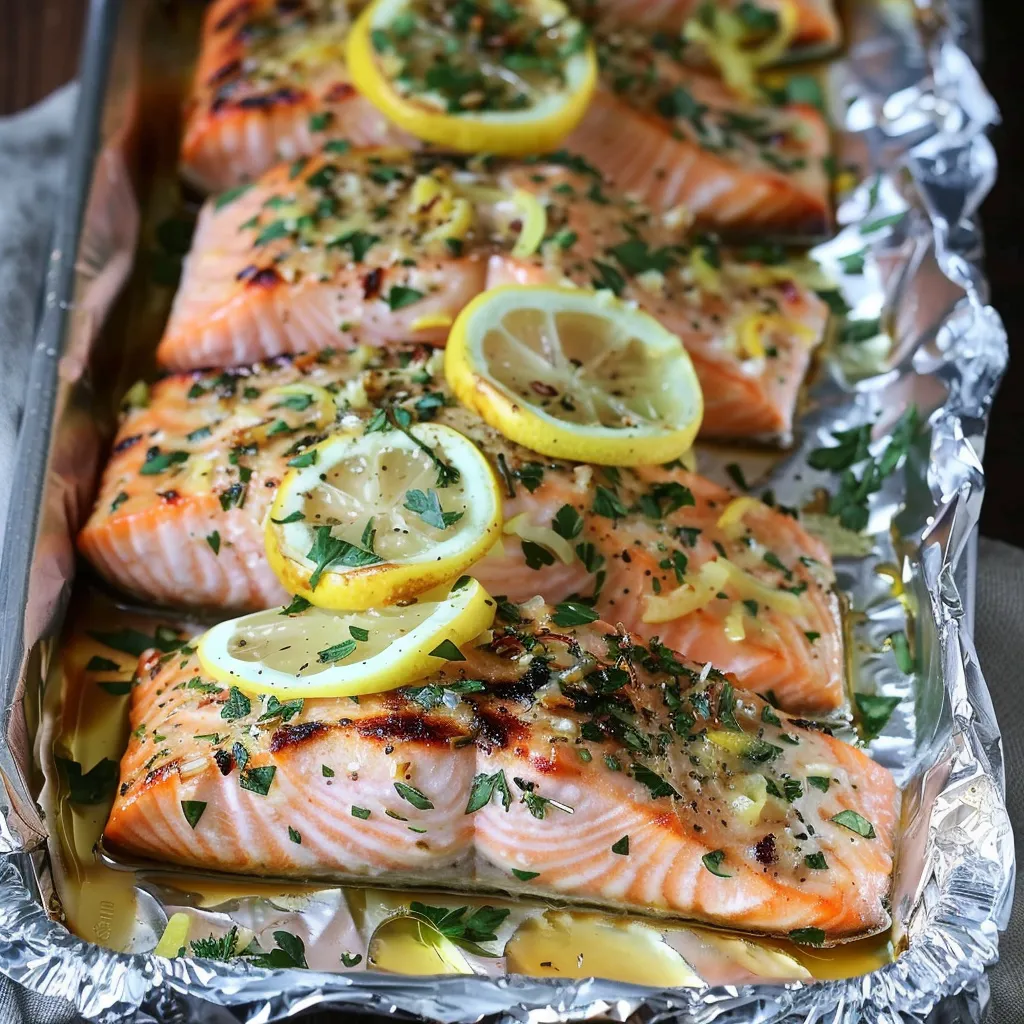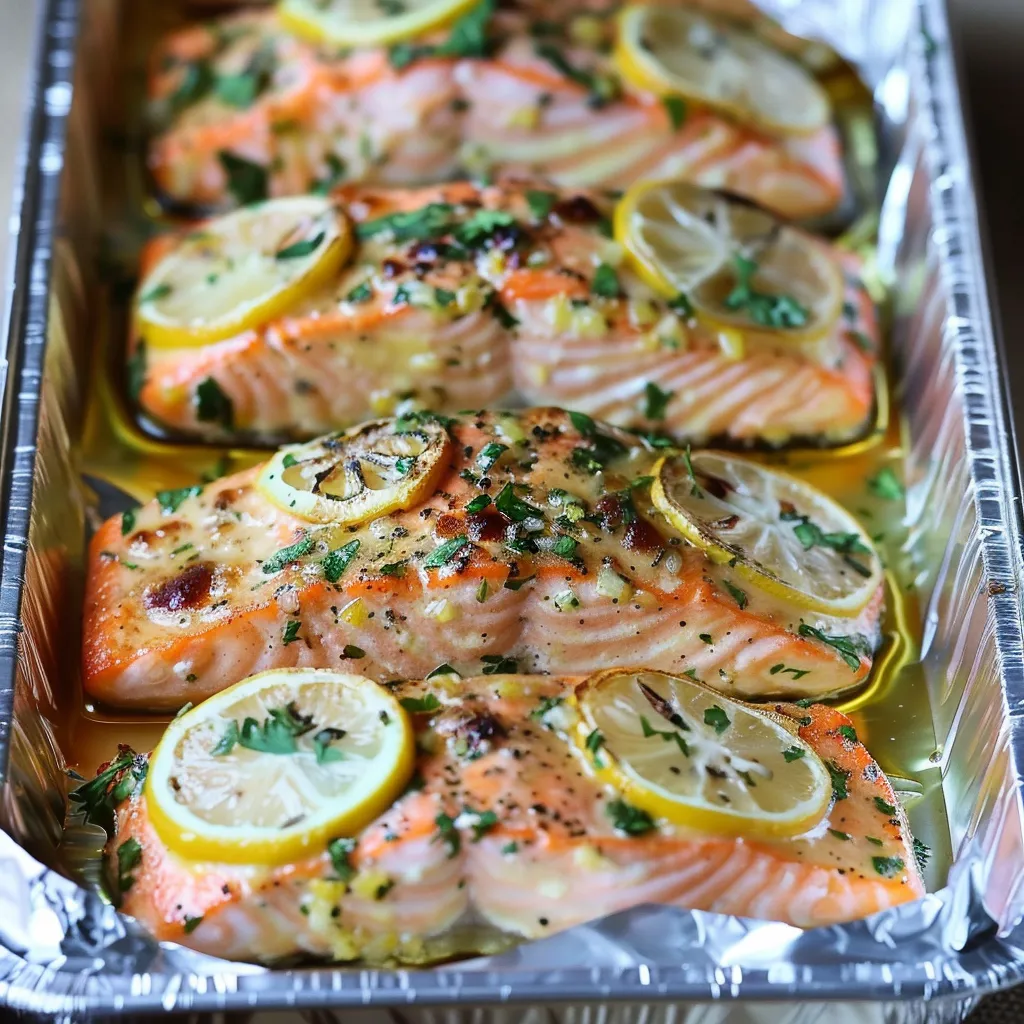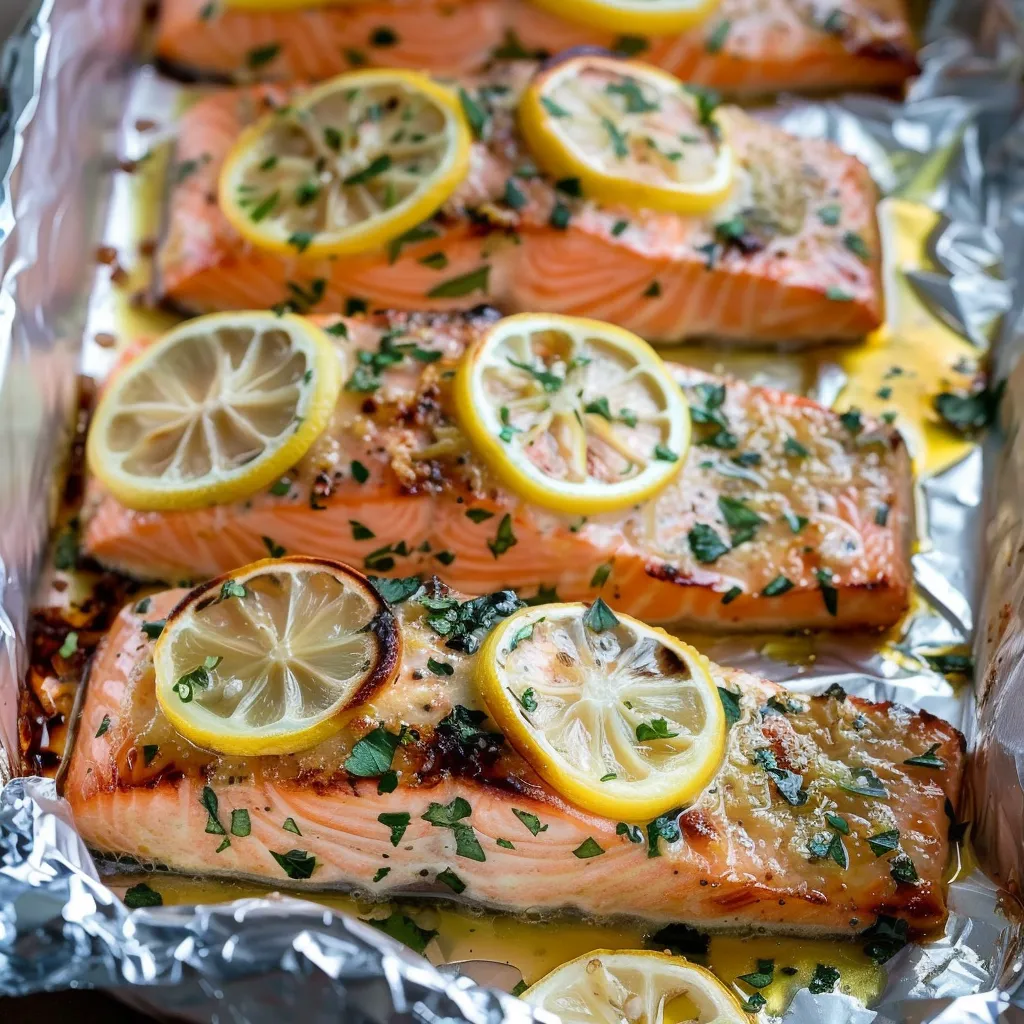 Pin it
Pin it
This hearty lemon baked salmon in foil has been my weeknight dinner savior for years. It delivers restaurant-quality flavor with minimal prep, making it perfect for both casual family meals and elegant entertaining.
I first discovered this cooking method during a particularly busy week when I needed something impressive yet effortless. Now it has become my go-to entertaining dish that always earns compliments even from guests who claim they don't enjoy seafood.
Ingredients
- Salmon fillets: With skin on creates a protective barrier during cooking and adds rich flavor
- Salted butter: Forms the base of our sauce providing richness and depth
- Fresh garlic cloves: Offer aromatic intensity that dried versions simply cannot match
- Fresh basil: Brings bright herbaceous notes that perfectly complement the salmon
- Fresh lemon juice: Adds essential acidity that balances the richness of the fish
- Salt and pepper: Enhance all other flavors and properly season the fish
- Lemon slices: Infuse additional citrus flavor while creating a beautiful presentation
Step-by-Step Instructions
- Prepare the Oven:
- Heat your oven to exactly 375°F. This moderate temperature ensures the salmon cooks gently without drying out. Allow your oven to fully preheat before adding the salmon for consistent results.
- Create the Flavor Base:
- Combine melted butter with minced garlic, chopped fresh basil, lemon juice, salt and pepper in a small bowl. Whisk thoroughly until fully incorporated. This aromatic mixture will infuse into the salmon as it cooks, creating layers of flavor.
- Prepare the Cooking Packet:
- Lay a large sheet of aluminum foil on a baking sheet then place a slightly smaller piece of parchment paper on top. This dual-layer approach prevents sticking while creating a perfect steaming environment. Position the salmon fillets on the parchment with small gaps between each piece to ensure even cooking.
- Apply Initial Flavoring:
- Pour half of your prepared lemon basil sauce evenly over the salmon fillets. Reserve the remaining sauce for later use. Place a fresh lemon slice atop each fillet which will release oils and flavor during cooking.
- First Baking Phase:
- Carefully fold the parchment and foil around the salmon creating a sealed packet. Bake for 14 to 16 minutes which allows the fish to gently steam in its own juices along with the flavorful sauce.
- Final Flavor Boost:
- Open the foil packet carefully as hot steam will escape. Pour the remaining lemon basil sauce over the partially cooked fillets then return to the oven under the broiler for 5 to 7 minutes. Watch closely as the broiler works quickly to create a beautiful slightly browned finish.
 Pin it
Pin it
I discovered that using both parchment and foil creates the perfect cooking environment something I learned from a chef friend who praised this method for its ability to lock in moisture. My family particularly loves when I make this with wild caught salmon which has a more pronounced flavor profile.
The Perfect Salmon Selection
Choose center cut salmon pieces for the most even cooking. Look for salmon with bright flesh a subtle sea smell and firm texture. Wild caught varieties like sockeye or coho work beautifully in this recipe though farm raised Atlantic salmon creates a more buttery result. When possible ask your fishmonger to remove pin bones which saves preparation time at home.
Customizing Your Flavor Profile
This recipe serves as an excellent base for countless variations. Try substituting dill for the basil for a more traditional pairing. Minced shallots can replace or complement the garlic for a milder allium flavor. Add a teaspoon of Dijon mustard to the butter mixture for a subtle tang or incorporate a splash of white wine for complexity. For heat lovers a pinch of red pepper flakes creates a gentle warmth that enhances without overwhelming.
Serving Suggestions
Serve this salmon alongside roasted asparagus or green beans which cook at the same temperature in about the same time. A side of fluffy couscous or quinoa makes an ideal accompaniment to absorb the delicious sauce. For a complete meal consider starting with a light cucumber salad dressed simply with lemon and olive oil. This salmon also makes excellent leftovers flaked over mixed greens for lunch the following day.
 Pin it
Pin it
This method guarantees succulent salmon that tastes like it came straight from a restaurant kitchen! Don't forget to save any extras for an easy, flavorful lunch the next day.
Frequently Asked Questions
- → Can I use parchment paper instead of foil for this salmon?
While the recipe calls for both foil and parchment paper together, you can use parchment paper alone. However, foil helps seal in moisture better and creates a tighter seal. If using only parchment, create a well-folded packet and expect slightly different results.
- → How can I tell when the salmon is perfectly cooked?
Perfectly cooked salmon will be opaque on the outside while still slightly translucent in the center. It should flake easily with a fork but remain moist. For this recipe, the recommended 14-16 minutes of baking plus 5-7 minutes of broiling should yield ideal results.
- → Can I use dried herbs instead of fresh basil?
While fresh basil provides the best flavor, you can substitute dried basil in a pinch. Use about 2 teaspoons of dried basil instead of 2 tablespoons fresh. However, as the recipe notes mention, fresh ingredients significantly enhance the flavor profile.
- → What side dishes pair well with this lemon salmon?
This salmon pairs beautifully with roasted asparagus, steamed broccoli, garlic mashed potatoes, or a light quinoa salad. The bright lemon flavor complements most vegetables, and a starchy side helps balance the meal.
- → Can this salmon be prepared ahead of time?
You can prepare the lemon-basil sauce up to 24 hours ahead and refrigerate it. You can also assemble the foil packets a few hours before cooking. For best results, however, bake just before serving, as salmon tastes best when freshly cooked.
- → Is it necessary to broil the salmon after baking?
The broiling step adds color and concentrates the flavors of the second application of sauce. While technically optional, this step elevates the dish significantly by creating a slightly caramelized finish and ensuring the final sauce coating adheres beautifully to the fish.
